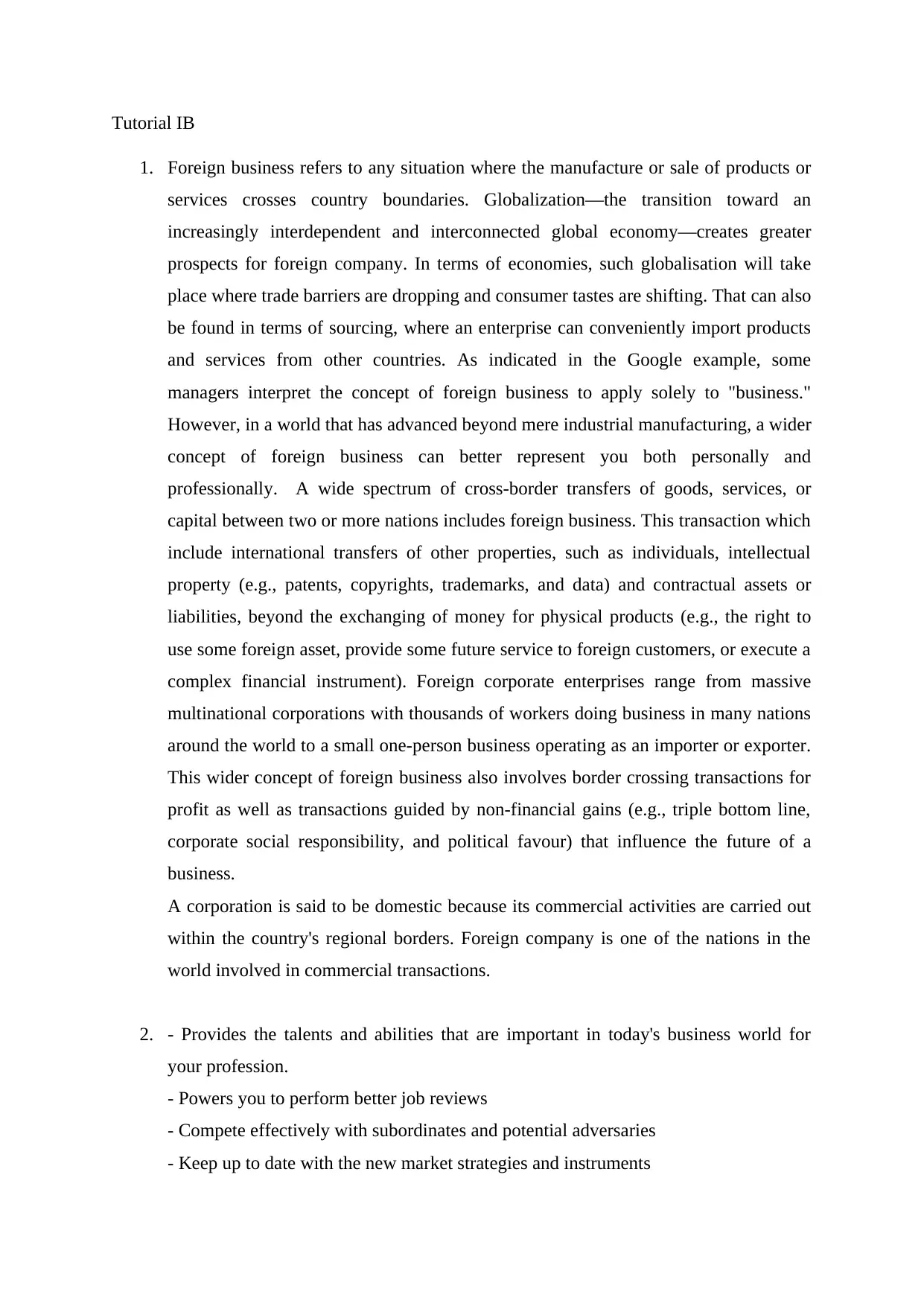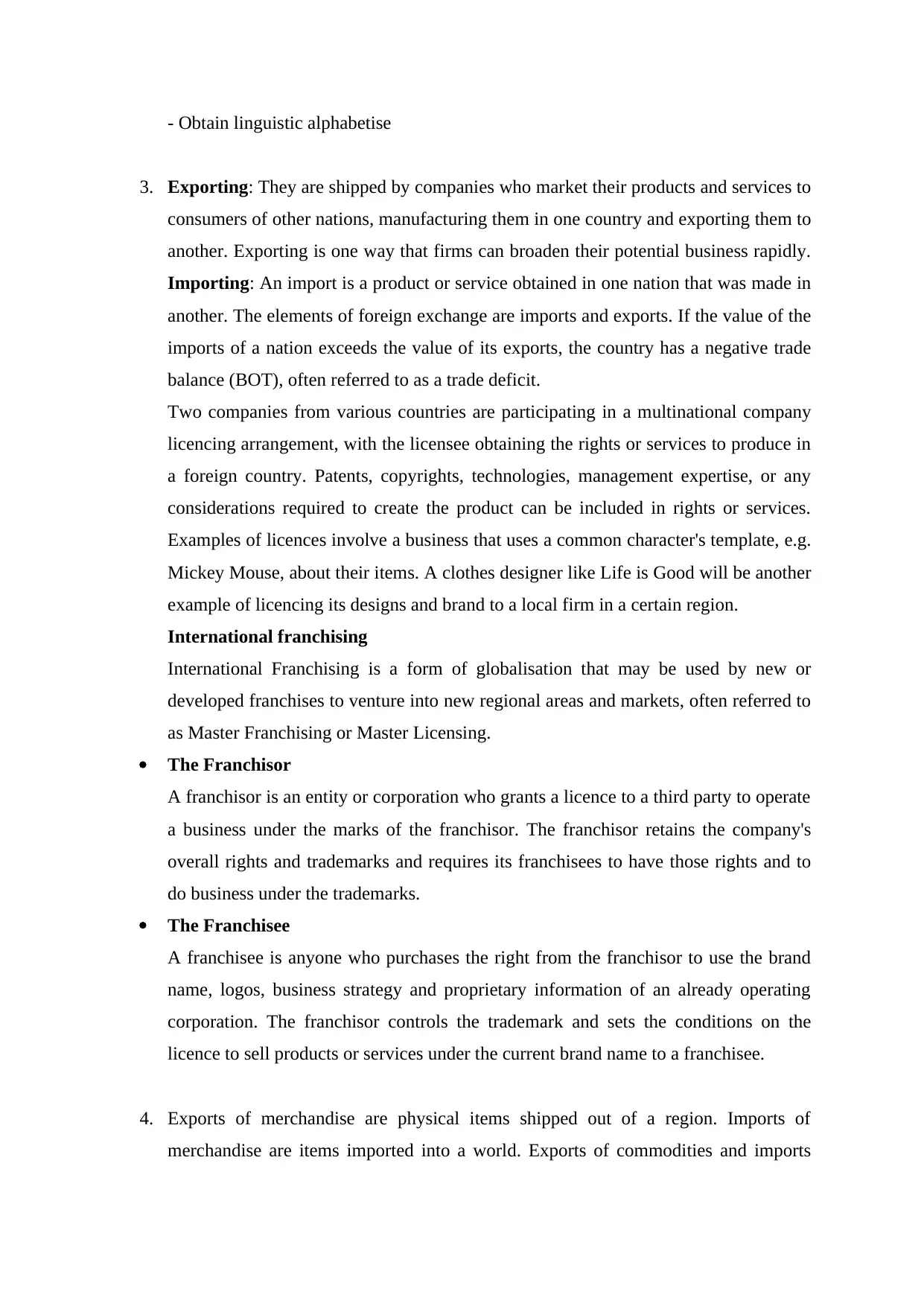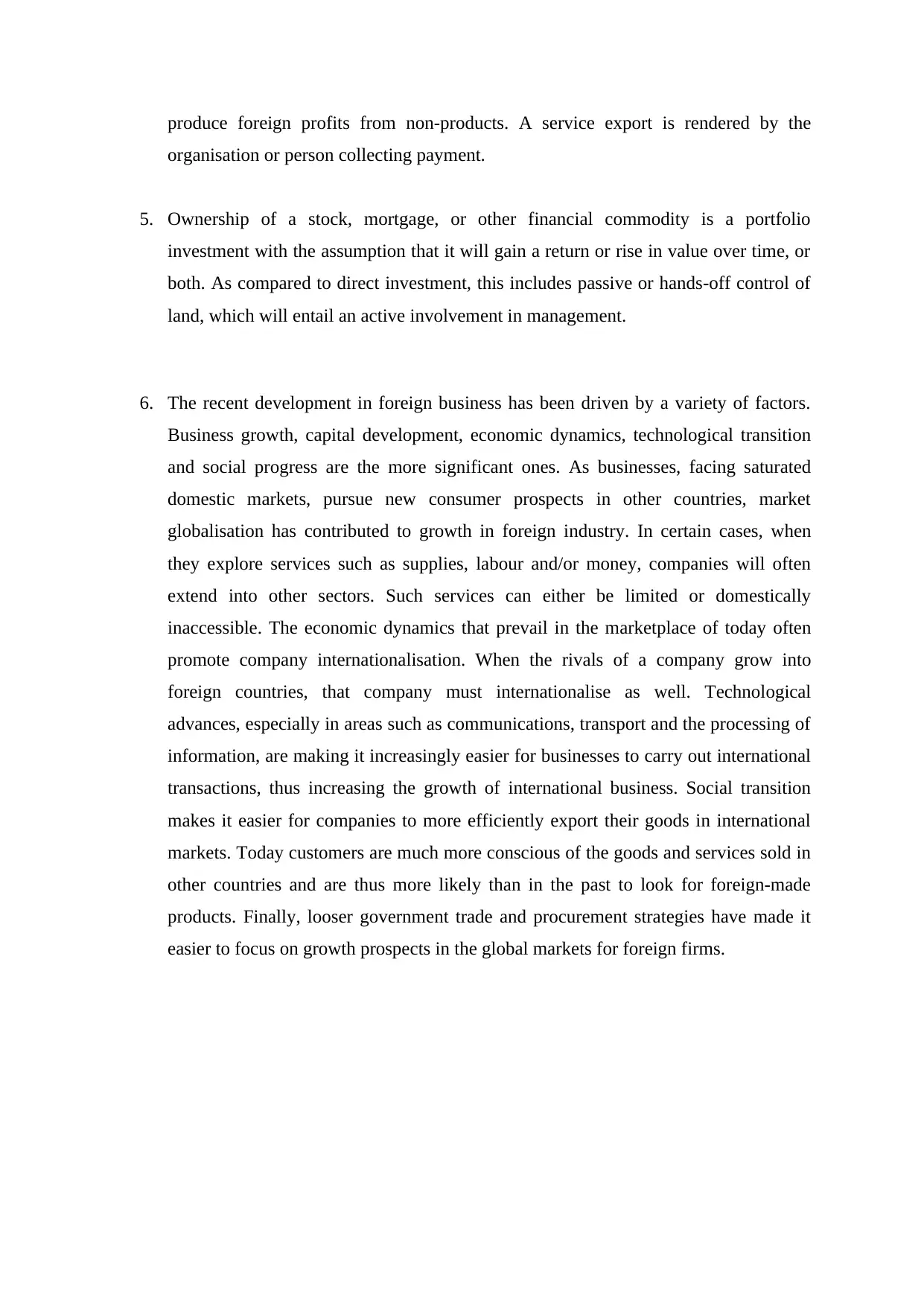Comprehensive Report: IB Foreign Business Concepts and Strategies
VerifiedAdded on 2020/12/07
|3
|1086
|62
Report
AI Summary
This report delves into the multifaceted realm of foreign business, providing a comprehensive overview of its core concepts and operational strategies. It begins by defining foreign business and its significance in a globalized economy, emphasizing the role of international trade and the impact of dropping trade barriers and shifting consumer preferences. The report then examines various facets of foreign business, including exporting, importing, licensing, and international franchising, illustrating each with real-world examples. It further differentiates between domestic and foreign corporations and explores the factors driving the growth of foreign business, such as market globalization, capital development, economic dynamics, technological advancements, and social transitions. The report highlights the importance of understanding these elements for businesses seeking to expand internationally, offering insights into the complexities and opportunities within the global market.

Tutorial IB
1. Foreign business refers to any situation where the manufacture or sale of products or
services crosses country boundaries. Globalization—the transition toward an
increasingly interdependent and interconnected global economy—creates greater
prospects for foreign company. In terms of economies, such globalisation will take
place where trade barriers are dropping and consumer tastes are shifting. That can also
be found in terms of sourcing, where an enterprise can conveniently import products
and services from other countries. As indicated in the Google example, some
managers interpret the concept of foreign business to apply solely to "business."
However, in a world that has advanced beyond mere industrial manufacturing, a wider
concept of foreign business can better represent you both personally and
professionally. A wide spectrum of cross-border transfers of goods, services, or
capital between two or more nations includes foreign business. This transaction which
include international transfers of other properties, such as individuals, intellectual
property (e.g., patents, copyrights, trademarks, and data) and contractual assets or
liabilities, beyond the exchanging of money for physical products (e.g., the right to
use some foreign asset, provide some future service to foreign customers, or execute a
complex financial instrument). Foreign corporate enterprises range from massive
multinational corporations with thousands of workers doing business in many nations
around the world to a small one-person business operating as an importer or exporter.
This wider concept of foreign business also involves border crossing transactions for
profit as well as transactions guided by non-financial gains (e.g., triple bottom line,
corporate social responsibility, and political favour) that influence the future of a
business.
A corporation is said to be domestic because its commercial activities are carried out
within the country's regional borders. Foreign company is one of the nations in the
world involved in commercial transactions.
2. - Provides the talents and abilities that are important in today's business world for
your profession.
- Powers you to perform better job reviews
- Compete effectively with subordinates and potential adversaries
- Keep up to date with the new market strategies and instruments
1. Foreign business refers to any situation where the manufacture or sale of products or
services crosses country boundaries. Globalization—the transition toward an
increasingly interdependent and interconnected global economy—creates greater
prospects for foreign company. In terms of economies, such globalisation will take
place where trade barriers are dropping and consumer tastes are shifting. That can also
be found in terms of sourcing, where an enterprise can conveniently import products
and services from other countries. As indicated in the Google example, some
managers interpret the concept of foreign business to apply solely to "business."
However, in a world that has advanced beyond mere industrial manufacturing, a wider
concept of foreign business can better represent you both personally and
professionally. A wide spectrum of cross-border transfers of goods, services, or
capital between two or more nations includes foreign business. This transaction which
include international transfers of other properties, such as individuals, intellectual
property (e.g., patents, copyrights, trademarks, and data) and contractual assets or
liabilities, beyond the exchanging of money for physical products (e.g., the right to
use some foreign asset, provide some future service to foreign customers, or execute a
complex financial instrument). Foreign corporate enterprises range from massive
multinational corporations with thousands of workers doing business in many nations
around the world to a small one-person business operating as an importer or exporter.
This wider concept of foreign business also involves border crossing transactions for
profit as well as transactions guided by non-financial gains (e.g., triple bottom line,
corporate social responsibility, and political favour) that influence the future of a
business.
A corporation is said to be domestic because its commercial activities are carried out
within the country's regional borders. Foreign company is one of the nations in the
world involved in commercial transactions.
2. - Provides the talents and abilities that are important in today's business world for
your profession.
- Powers you to perform better job reviews
- Compete effectively with subordinates and potential adversaries
- Keep up to date with the new market strategies and instruments
Paraphrase This Document
Need a fresh take? Get an instant paraphrase of this document with our AI Paraphraser

- Obtain linguistic alphabetise
3. Exporting: They are shipped by companies who market their products and services to
consumers of other nations, manufacturing them in one country and exporting them to
another. Exporting is one way that firms can broaden their potential business rapidly.
Importing: An import is a product or service obtained in one nation that was made in
another. The elements of foreign exchange are imports and exports. If the value of the
imports of a nation exceeds the value of its exports, the country has a negative trade
balance (BOT), often referred to as a trade deficit.
Two companies from various countries are participating in a multinational company
licencing arrangement, with the licensee obtaining the rights or services to produce in
a foreign country. Patents, copyrights, technologies, management expertise, or any
considerations required to create the product can be included in rights or services.
Examples of licences involve a business that uses a common character's template, e.g.
Mickey Mouse, about their items. A clothes designer like Life is Good will be another
example of licencing its designs and brand to a local firm in a certain region.
International franchising
International Franchising is a form of globalisation that may be used by new or
developed franchises to venture into new regional areas and markets, often referred to
as Master Franchising or Master Licensing.
The Franchisor
A franchisor is an entity or corporation who grants a licence to a third party to operate
a business under the marks of the franchisor. The franchisor retains the company's
overall rights and trademarks and requires its franchisees to have those rights and to
do business under the trademarks.
The Franchisee
A franchisee is anyone who purchases the right from the franchisor to use the brand
name, logos, business strategy and proprietary information of an already operating
corporation. The franchisor controls the trademark and sets the conditions on the
licence to sell products or services under the current brand name to a franchisee.
4. Exports of merchandise are physical items shipped out of a region. Imports of
merchandise are items imported into a world. Exports of commodities and imports
3. Exporting: They are shipped by companies who market their products and services to
consumers of other nations, manufacturing them in one country and exporting them to
another. Exporting is one way that firms can broaden their potential business rapidly.
Importing: An import is a product or service obtained in one nation that was made in
another. The elements of foreign exchange are imports and exports. If the value of the
imports of a nation exceeds the value of its exports, the country has a negative trade
balance (BOT), often referred to as a trade deficit.
Two companies from various countries are participating in a multinational company
licencing arrangement, with the licensee obtaining the rights or services to produce in
a foreign country. Patents, copyrights, technologies, management expertise, or any
considerations required to create the product can be included in rights or services.
Examples of licences involve a business that uses a common character's template, e.g.
Mickey Mouse, about their items. A clothes designer like Life is Good will be another
example of licencing its designs and brand to a local firm in a certain region.
International franchising
International Franchising is a form of globalisation that may be used by new or
developed franchises to venture into new regional areas and markets, often referred to
as Master Franchising or Master Licensing.
The Franchisor
A franchisor is an entity or corporation who grants a licence to a third party to operate
a business under the marks of the franchisor. The franchisor retains the company's
overall rights and trademarks and requires its franchisees to have those rights and to
do business under the trademarks.
The Franchisee
A franchisee is anyone who purchases the right from the franchisor to use the brand
name, logos, business strategy and proprietary information of an already operating
corporation. The franchisor controls the trademark and sets the conditions on the
licence to sell products or services under the current brand name to a franchisee.
4. Exports of merchandise are physical items shipped out of a region. Imports of
merchandise are items imported into a world. Exports of commodities and imports

produce foreign profits from non-products. A service export is rendered by the
organisation or person collecting payment.
5. Ownership of a stock, mortgage, or other financial commodity is a portfolio
investment with the assumption that it will gain a return or rise in value over time, or
both. As compared to direct investment, this includes passive or hands-off control of
land, which will entail an active involvement in management.
6. The recent development in foreign business has been driven by a variety of factors.
Business growth, capital development, economic dynamics, technological transition
and social progress are the more significant ones. As businesses, facing saturated
domestic markets, pursue new consumer prospects in other countries, market
globalisation has contributed to growth in foreign industry. In certain cases, when
they explore services such as supplies, labour and/or money, companies will often
extend into other sectors. Such services can either be limited or domestically
inaccessible. The economic dynamics that prevail in the marketplace of today often
promote company internationalisation. When the rivals of a company grow into
foreign countries, that company must internationalise as well. Technological
advances, especially in areas such as communications, transport and the processing of
information, are making it increasingly easier for businesses to carry out international
transactions, thus increasing the growth of international business. Social transition
makes it easier for companies to more efficiently export their goods in international
markets. Today customers are much more conscious of the goods and services sold in
other countries and are thus more likely than in the past to look for foreign-made
products. Finally, looser government trade and procurement strategies have made it
easier to focus on growth prospects in the global markets for foreign firms.
organisation or person collecting payment.
5. Ownership of a stock, mortgage, or other financial commodity is a portfolio
investment with the assumption that it will gain a return or rise in value over time, or
both. As compared to direct investment, this includes passive or hands-off control of
land, which will entail an active involvement in management.
6. The recent development in foreign business has been driven by a variety of factors.
Business growth, capital development, economic dynamics, technological transition
and social progress are the more significant ones. As businesses, facing saturated
domestic markets, pursue new consumer prospects in other countries, market
globalisation has contributed to growth in foreign industry. In certain cases, when
they explore services such as supplies, labour and/or money, companies will often
extend into other sectors. Such services can either be limited or domestically
inaccessible. The economic dynamics that prevail in the marketplace of today often
promote company internationalisation. When the rivals of a company grow into
foreign countries, that company must internationalise as well. Technological
advances, especially in areas such as communications, transport and the processing of
information, are making it increasingly easier for businesses to carry out international
transactions, thus increasing the growth of international business. Social transition
makes it easier for companies to more efficiently export their goods in international
markets. Today customers are much more conscious of the goods and services sold in
other countries and are thus more likely than in the past to look for foreign-made
products. Finally, looser government trade and procurement strategies have made it
easier to focus on growth prospects in the global markets for foreign firms.
⊘ This is a preview!⊘
Do you want full access?
Subscribe today to unlock all pages.

Trusted by 1+ million students worldwide
1 out of 3
Related Documents
Your All-in-One AI-Powered Toolkit for Academic Success.
+13062052269
info@desklib.com
Available 24*7 on WhatsApp / Email
![[object Object]](/_next/static/media/star-bottom.7253800d.svg)
Unlock your academic potential
Copyright © 2020–2025 A2Z Services. All Rights Reserved. Developed and managed by ZUCOL.





